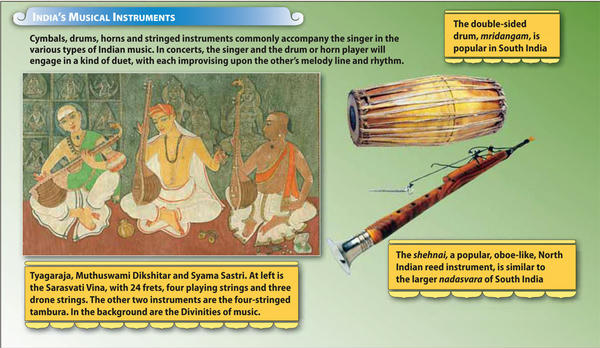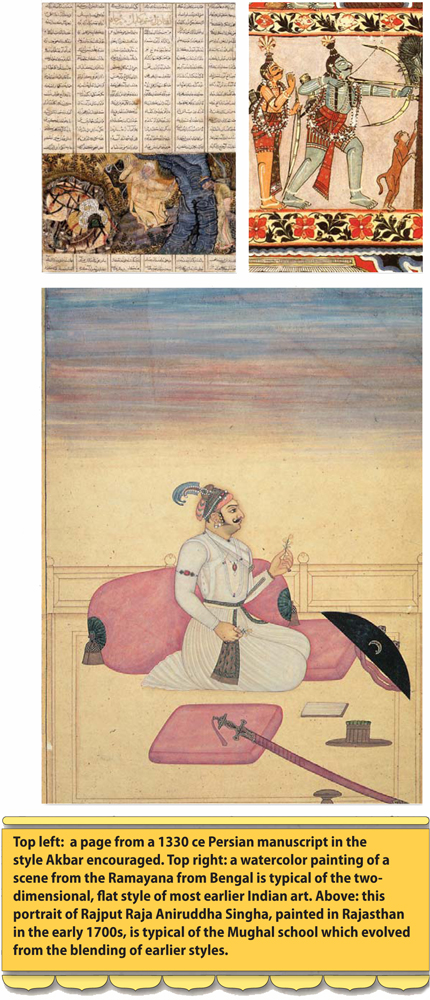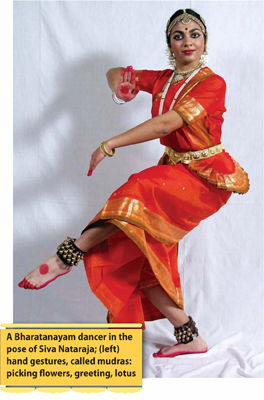Music, Art, Dance and Architecture
What You Will Learn...§
Main Ideas§
1. India has rich artistic traditions of music, dance, drama, painting and architecture.§
2. These arts are closely tied to the Hindu religion.§
3. Muslim rule brought Persian influence to Indian painting and architecture.§
The Big Idea§
Islamic culture influenced some forms of Indian art, while others remained largely unaffected.
Key Terms§
![]() HINDUISM TODAY’S TEACHING STANDARDS§
HINDUISM TODAY’S TEACHING STANDARDS§
If YOU lived then...
Your father is an artist hired by Mughal Emperor Akbar in Delhi. The emperor has brought great painters from Persia. He wants to develop a new art style. You have been an apprentice to your father for several years now, but now you both must learn a new artistic style. Your father thinks it will be valuable to learn from the Persians.§
How do you feel about learning the new art form?§
BUILDING BACKGROUND: The arts, such as painting, music, dance and architecture, are essential parts of every culture. Flourishing civilizations develop new artistic styles over time. Fresh ideas appear and blend with old traditions, allowing artists to express the culture, thoughts and emotions of the time in beautiful, uplifting works.§
Artistic Achievements
Art within Hindu India was already highly developed prior to the Arab, Turkic and Mughal invasions. Some art forms, such as music and dance, were less affected by these invasions, especially in the South where Hindu rule was the norm. In the North, Persian building design, with its arches and domes, became common, and in painting, the Mughal emperors stimulated a harmonious blending of composition and method, thus creating the Indo-Islamic art style.§
A Rich History of Music
India has always had an extraordinarily diverse musical scene. This ranges from the complex works of the classical tradition to the villagers’ simple work songs and devotional hymns in local languages. Temple stone workers, for example, sing together to coordinate the effort of moving a heavy stone. At a certain point in the song, all apply perfectly timed force to their iron pry bars. In this way, stones weighing tons can be moved by hand. To this day, Hindu men and women sing devotional songs to accompany and ease their daily tasks.§
There is within Hinduism a long tradition of bhajana and kirtana, call-and-response devotional singing of simple songs, usually in small groups with musical accompaniment. Katha is a popular form of storytelling, occurring in multiple sessions, often spanning many days. A highly skilled storyteller will recount episodes from sacred texts, such as the Ramayana, then lead the audience in singing related bhajanas.§
Alongside these basic musical traditions is India’s classical Carnatic music. Three great innovators of this ancient system lived in South India in the late 18th and early 19th centuries: Tyagaraja, Muthuswami Dikshitar and Syama Sastri. They systematized and improved upon the existing framework of raga and tala, the essentials of Indian music. Hindustani is a related musical system that arose in the North as musicians blended Persian elements into the Indian tradition.§
First, the composer selects a raga in which to write his song. A raga is a pattern of notes upon which a melody is made. Ragas include notes from the seven-note Indian scale (sa, ri, ga, ma, pa, dha, ni) as well as microtones, which are like the sharps and flats of Western music, only more numerous. This multiplicity of tones allows for the creation of thousands of ragas. Next, the composer selects a tala, or rhythmic pattern. Talas range from the simple and most common eight-beat Adi tala to elaborate rhythms such as the Dhamar tala, composed of 14 beats divided as 5, 2, 3 and 4.§
Songs were written in Sanskrit and increasingly in the regional languages, such as Hindi, Telegu and Tamil. Singers and musicians improvise upon the basic melody while keeping within the chosen raga and tala. The results are always creative, akin to the improvisations in Western jazz. This is one key way that Indian classical music differs from Western classical music, which is usually played exactly as it was composed.§

A Meeting of Art Styles
The Mughal emperors were responsible for a major advancement in painting which eventually influenced much of India. Earlier Muslim rulers started the process by bringing artists to India to illustrate the elaborate handwritten books of the time (see top left on page 14). These painters had been influenced earlier by Chinese artists who were brought to Persia by conquering Mongols.§
The Mughal Emperor Akbar, trained in art as a child, encouraged a true synthesis of forms. He commissioned craftsmen by the hundreds in an almost factory-like setting under his Royal Bureau of Books. This enterprise, headed by the great Persian artists, Khwaja Abdus Samad and Mir Sayyid Ali, resulted in major artistic innovations.§
As the Mughal Empire declined, this huge community of artists lost their rich patronage. The last emperor, Aurangzeb, dismissed the artists and banned music and dance. He judged their work contrary to Islamic teachings that prohibit the depiction of religious themes in any art form. Hindu and Muslim artists turned to independent local rulers across India for support. Many applied the new techniques to Hindu subjects, especially illustrating the Mahabharata and stories of Lord Krishna.§
Indian painting before this time was two-dimensional, as seen in the example at top left. The new style adopted typical Indian colors, used delicate brush lines (some made with a brush of a single squirrel hair) and introduced better lighting effects. Advancements were also made in the preparation of pigments and paints, allowing for a greater range and depth of color.§
During the British rule, a blending of painting styles was attempted between Indo-Islamic and European art. The result, called Company style, tended toward realism, and was later displaced by the invention of photography.§

Architecture
In South India during this period, the art of temple building reached its peak. In fact, Hindu temples today are still built according to the styles developed at this time, following principles from the ancient Agama texts. In North India, Hindu architecture was eventually strongly influenced by Persian design, especially the use of the dome and arch. The most spectacular construction during the period was the Taj Mahal, among the world’s most elegant buildings. Built in white marble by Shah Jahan to entomb his beloved wife, the Taj, with its immense domes and towering minarets, is Persian in design with many Hindu elements. Completed in 1653, it took 20,000 craftsmen working 22 years to build and was a great drain on the treasury. Shah Jahan was overthrown and imprisoned by his son, Aurangzeb, shortly after its completion.§
RELIGION THROUGH MOVEMENT§
Bharatanatyam and the related dances Kuchipudi and Odissi come from the ancient temple dances of South India, described in the 2,000-year-old Natya Shastra. Originally, dance, accompanied by classical Indian music, was one of the sixteen offerings made during the ritual worship called puja. Indian dance is not simply entertainment, but a religious experience both for the dancer and the audience. Early dance tradition used improvisation, as does Indian music, but today the choreography is usually set. Most dances are depictions of religious stories, told through poses, movements and dozens of meaningful hand gestures called mudras.§
When the first Bharatanatyam dancers came to Europe in 1838, a reviewer wrote, “The dancers of all Europe dance with their feet, but that is all. The Indians dance in a different manner. They dance with their whole frame. Their heads dance, their arms dance. Their eyes, above all, obey the movement and fury of the dance. Their feet click against the floor; the arms and the hands flash in the air; the eyes sparkle; their mouths mutter; the whole body quivers.”§
CHAPTER SUMMARY
Beginning in 1100, Muslim armies conquered vast regions of India. Despite repeated defeats, the Rajput and other Hindu rulers refused to surrender. South India, far from the Muslim capitals of Delhi and Agra, escaped the unceasing warfare and foreign dominance that beset North India, suffering only periodic raids. Wherever Hindus were conquered, resistance continued, mainly on a social and religious level. The caste system did not break down under the alien rule, so the social structure remained stable. Most Hindus did not convert to Islam, despite heavy pressure. The arrival of the East India Company changed the political situation. By force and skillful tactics, the British slowly gained complete control of India.§
REVIEWING IDEAS, TERMS AND PEOPLE§
- Describe: What are the roles of raga, tala and improvisation in Indian classical music?
- Analyze: What were some of the advancements made in painting under the Mughals? What made these advancements possible?
- Contrast: How did the architecture of this period differ in North and South India and why?

- Synthesize: How does the mixing of cultures result in new artistic styles? Give examples from your society.
Modern katha performers attract crowds of thousands in the US and England, and hundreds of thousands in India.§
ACADEMIC VOCABULARY§
systematize§
to arrange in an orderly fashion§
improvise§
in music, to create and perform spontaneously§
Nataraja§
“King of Dance,” a form of Lord Siva§




